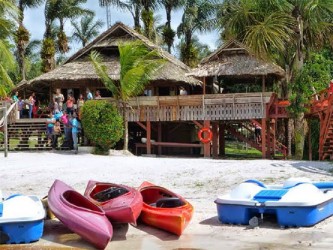The Tourism and Hospitality association of Guyana (THAG) continues to have serious doubts about the state of the sector’s health as well as misgivings about government’s commitment to the creation of a viable tourism sector, THAG President Christopher ‘Kit’ Nascimento has said.
Nascimento said Guyana’s tourism product compares favourably with any other in the Caribbean, and places the blame for its underdevelopment on government. Though the local industry offers as much as any other in the Caribbean, he said, over the years, government has shown less than wholehearted inclination to commit to the industry. “The problem I have as President of THAG is that I am not yet convinced that the government’s commitment to moving forward with tourism as a major development direction is much more than rhetoric,” Nascimento told Stabroek Business.
These disclosures, made in an up-front interview, departed sharply from the conventional impression that THAG is comfortable with government policies on the sector.

THAG Vice President Nicole Correia said that while a lot of initiatives had come out of discourses between the government and THAG “there still seems to be no coherent plan for the development of the sector.”
The interview seemed designed to send a message that THAG wants the government to take a much greater share of the responsibility for the growth of the sector. And the two THAG executive members expressed the view that the need existed to make the association’s concerns about the state of the sector known.
Nascimento told Stabroek Business that “until tourism becomes a budget line item investors in the sector would have great difficulty in taking the government seriously.”
The THAG President is not the first tourism sector official to take the government to task over talking the talk but refusing to make what Nascimento believes are “the tough decisions” that will build investor confidence and further open up the sector to visitors from abroad. He said that while he was abundantly confident in the attractions that the country’s tourism sector had to offer, it continued to be “considerably uncompetitive” when compared with other tourism products in the region. “It is expensive from the time you get to Georgetown; then there is the cost of getting to the Rupununi,” Nascimento added.
The THAG President was also vocal in his criticism of “the level of taxes that we pay,” which he said are “considerably higher than the rest of the region.” He said the umbrella tourism body had, prior to the presentation of the 2014 budget, set out to government through the Private Sector Commission (PSC) its concerns relating to high taxes in the sector. “We put to them very specific written proposals comparing the concessions given on VAT in the region with those that apply here. We get no concessions even though there are significant concessions that could bring our prices down… Where we are disappointed is that on the question of budgetary issues such as concessions and taxes we were led to believe that the government would take on board our proposals with regard to pricing and we are very disappointed,” Nascimento said, adding that a meeting is expected to be convened with Finance Minister Dr Ashni Singh shortly to address tax concessions and other sector-related issues.

Nascimento told Stabroek Business that despite the understanding on “working together” between THAG and the government as reflected in the association occupying a seat on the Board of the Guyana Tourism Authority (GTA) government had neglected to consult with THAG on four recent important sectoral consultancies that had to do with the Cheddi Jagan International Airport, an ecotourism training strategy for Guyana, a tourism investment guide for Guyana and a marketing and branding strategy for Guyana. Nascimento said THAG was currently cooperating with the UK-based Acorn group on the marketing and branding strategy for Guyana, though “we were never asked as THAG whether we agreed to these engagements.”
And while last Friday’s inaugural landing at the Ogle International Airport by LIAT’s ATR72 70-seater aircraft, “opens up new possibilities for tourism” Guyana was not in a position to maximize the opportunity since our interior airstrips need to be expanded and properly maintained to take bigger aircraft,” Nascimento said.
“You can get a flow of tourists arriving at Ogle Airport, but then all we have are 12-seater aircraft to take them elsewhere. What we need are 30-seater aircraft to take them elsewhere. The major private sector aviation companies have said to the government that they are ready to invest in bigger aircraft, but invest in larger aircraft to go where? It has to be part of a package,” Nascimento added.





